
All images © by Roberto Piperno, owner of the domain. Write to romapip@quipo.it.
Notes:
Page revised in April 2023.

All images © by Roberto Piperno, owner of the domain. Write to romapip@quipo.it.
Notes:
Page revised in April 2023.
 - Genazzano
- GenazzanoGerman historian Ferdinand Gregorovius spent his first summer at Genazzano in 1856; he rented a small room under the roof of a house in the centre of the town; notwithstanding the modesty of his accommodation (in his diary he complained about the heat), he definitely enjoyed his holiday and he returned to Genazzano in the following years; he described the town in Aus der Campagna von Rom (The Roman Campagna) which was translated into English by Dorothea Roberts in 1902.
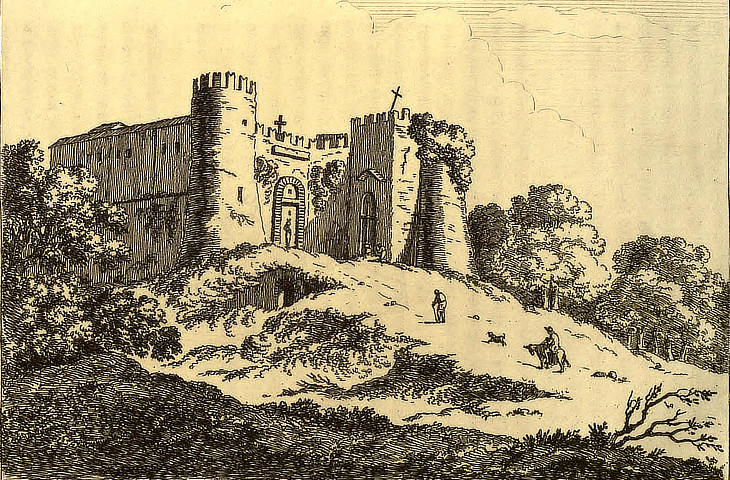
1805 Genazzano in a drawing by Ellis Cornelia Knight in "Description of Latium: or, La Campagna di Roma"
All the way from Cave is shaded by fine trees, and presents a constant succession of beautiful scenery.
Genazzano, the first appearance of which resembles a little fortress, is considered in this country as a second Loretto, on account of an image of the Madonna, reported to have flown over the sea from Albania in Macedon. It has a great reputation for miracles, and continually excites the devotion and curiosity of pilgrims. The Colonna family, to whom this town belongs, set a high value on it. Ellis Cornelia Knight
Of this glorious Latian land I would now talk to my friends, many of whom may have chosen the route to Naples by Frosinone and San Germano, in preference to the lower road by Terracina, and so will remember how beautiful is that valley of the Sacco, with its encircling mountains. I will link two of the towns together in this sketch - namely, Genazzano, a celebrated place of pilgrimage at the opening of the valley, and Anagni, the abode of many of the mediaeval Popes. Gregorovius
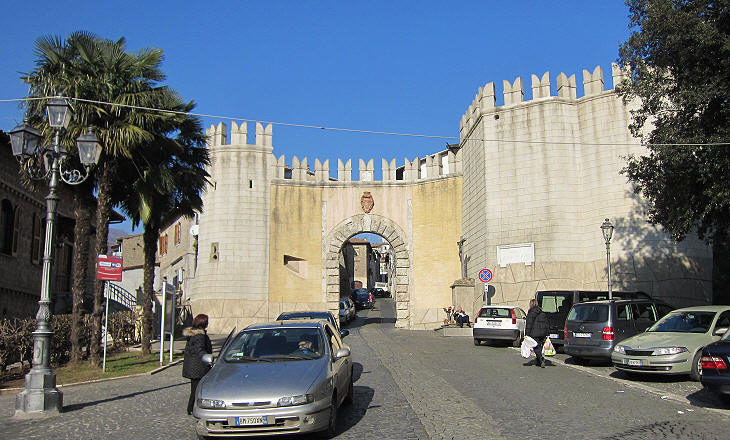
The gate of Genazzano
The road (from Cave) descended suddenly into a charming region of hill and dale, which alternated in the happiest way, a picture of rural prosperity, with its grey olive groves, shady chestnuts, corn and maize fields and gardens, and everywhere the little dome-shaped elm trees; festooning them, dark masses of grape-vines. (..) A tower with battlements defends the little town of Genazzano. Gregorovius
Genazzano is located a few miles east of Palestrina, but it is a much smaller town. It was built on a tufo ridge which was easily fortified by building a short wall on its southern side, because deep ravines protected it on the other ones.

On the long rocky hills enclosing this picture Genazzano stands, a narrow, dark grey strip, just like the tufa rocks on which it is founded. The houses look as if they were marching in procession to the shrine of Santa Maria del Buon Consiglio, the great sanctuary of the Latian Campagna, or else taking their way up to that beautiful baronial Colonna castle crowning the summit of the hill, the dutiful vassals of its lord. Gregorovius
Although the houses of Genazzano have been modernized since Gregorovius visited the town,
they still convey the image of a procession. The Colonna had the title of Signore di Genazzano, but they usually were referred to as counts or dukes of another of their fiefdoms or as First Prince Assistant to the Pontifical Throne, a hereditary title they acquired in the early XVIth century.
There are artistic fragments of baths in a ravine outside the gate of the town, which show, by their beauty, that they were built in the style-de-luxe prevailing in those days. Gregorovius
In a small valley near the main gate the Colonna built a nymphaeum which today is called Ninfeo del
Bramante, although no firm evidence has been found of the involvement of Donato Bramante (1444-1514), one of the leading architects of his time; most likely it was never
actually completed; the remaining walls have the appearance of ancient ruins, but the serliana design of the arches is typical of XVIth
century Renaissance.
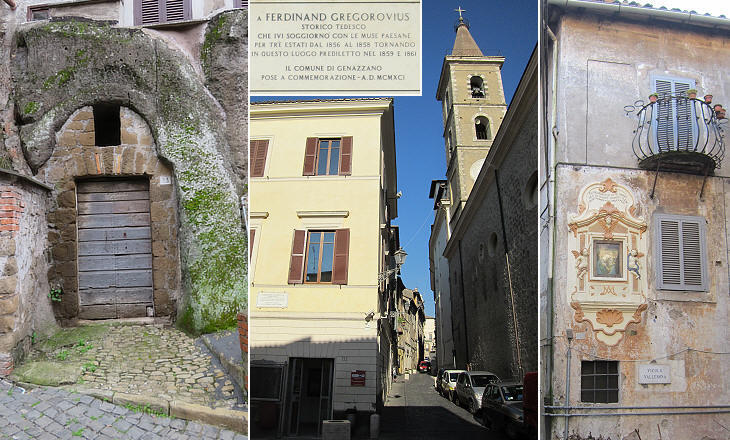
(left) A former stable in the lower, poorest part of the town which was cut into the rock; (centre) the main street between the house where Ferdinand Gregorovius sojourned and the bell tower of S. Maria del Buon Consiglio;
(right) a picturesque corner
All the churches and other important buildings of Genazzano are aligned along the street which crosses the whole town
from the gate to Palazzo Colonna; a plaque commemorates Gregorovius who in 1857 returned to Genazzano; he was not the only foreigner staying in this house opposite S. Maria del Buon Consiglio as in his diary he mentioned having met Thomas Buchanan Read, an American poet and painter and his pretty wife.
Some verses by Buchanan Read are similar to the account Gregorovius made of his walks in the countryside near Genazzano.
The reference to sandal shoes is due to ciocie, a sort of sandals which were typical of the peasants of the region, hence Ciociaria or "Sandal-land". In 1859 Gregorovius stayed at another place in Genazzano with two painters: Karl Lindemann-Frommel (German) and Hugo Oskar Von Mohrenschild (Estonian); he went there again in 1861.
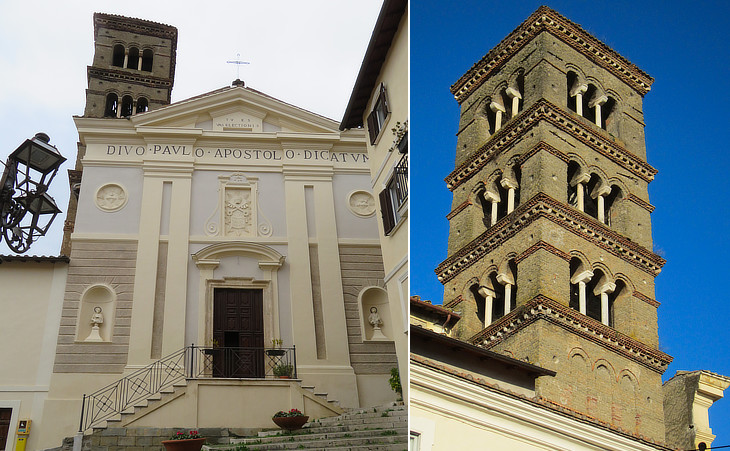
S. Paolo: (left) 1829 fašade; (right) XIIIth century bell tower
S. Paolo was most likely built in the XIIIth century and it is mentioned by local chronicles as Colleggiata Primaria Maggiore e Matrice, the main church of Genazzano. The bell tower is very similar to those of Rome, in particular to that of S. Maria in Cosmedin and it was not modified by the redesign of the church in the XVIIIth and XIXth centuries.
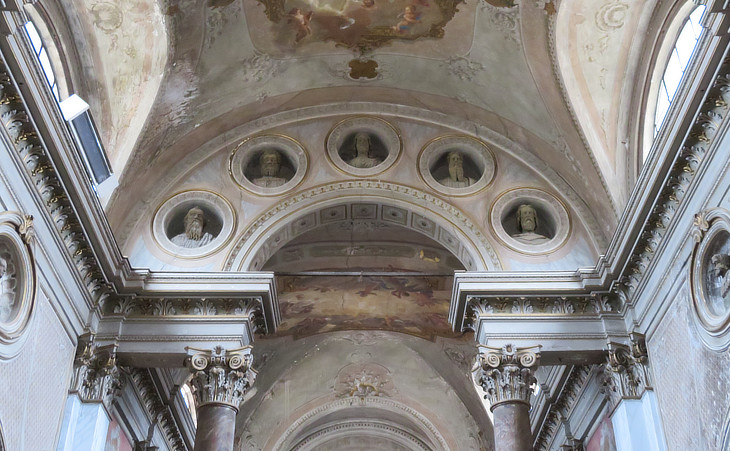
S. Paolo: interior with a Renaissance arch similar to those of the nymphaeum and of the dome of Chiesa della Maddalena at nearby Capranica
In 1480 Imperiale Colonna, wife of Antonio Colonna, Signore di Genazzano, made a large bequest to the church which might have been used to decorate it with a very elaborate Renaissance arch, which is almost unique.
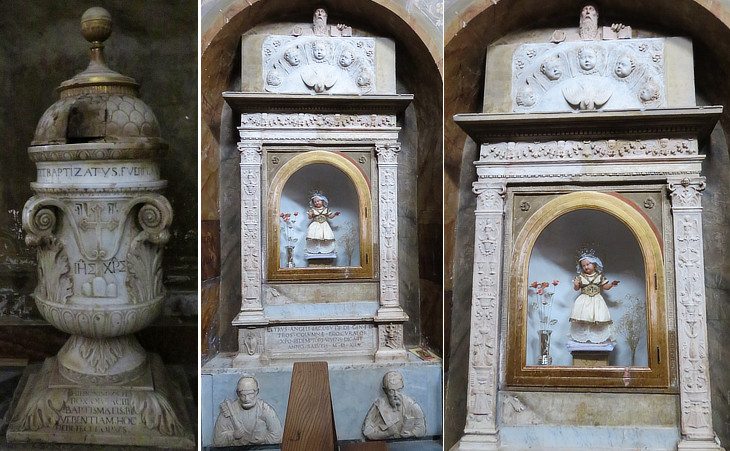
S. Paolo: (left) baptismal font roughly resembling a capital (XVIth century); (centre/right) 1512 tabernacle placed above two XIIIth century busts of St. Peter and St. Paul
The XVIth century was a period of wealth and military strength for the Colonna who gained the trust and support of Emperor Charles V. In this period S. Paolo was embellished with some fine marble monuments, which however were not paid attention to by XIXth century travellers.
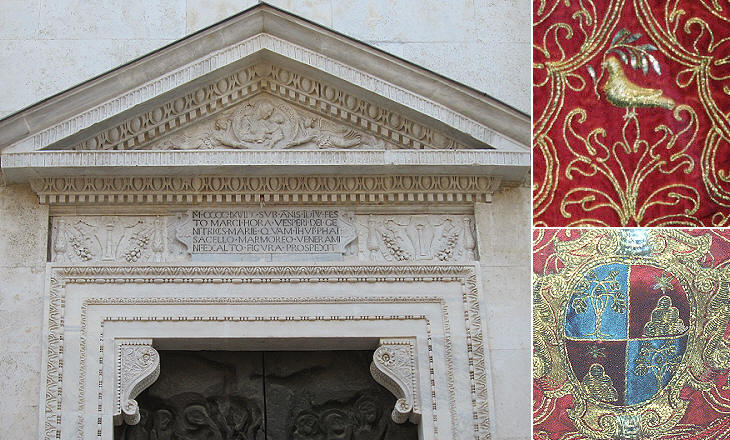
(left) Late XVth century main portal of S. Maria del Buon Consiglio; (right) details of a chasuble donated by
Pope Alexander VII but bearing also the
heraldic symbol (a dove) of Pope Innocent X
S. Maria del Buon Consiglio was (today slightly less) a famous sanctuary owing to a sacred image which miraculously moved from Scutari in Albania to Genazzano in 1467 when that country was conquered by the Ottomans. The popes used to make presents to the church: among them a finely embroidered chasuble, which was most likely started during the pontificate of Pope Innocent X and completed during that of Pope Alexander VII. The fašade of the church was redesigned in the XIXth century, but it retains the original Renaissance portal which was decorated with the coats of arms of the Colonna family (also in the image used as background for this page).
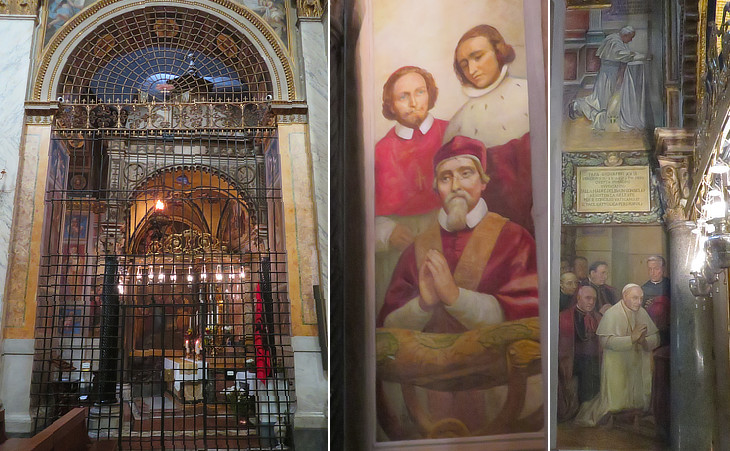
(left) Chapel of the icon of S. Maria del Buon Consiglio; (centre/right) frescoes portraying popes in prayer: Urban VIII (in 1630), John Paul II (in 1993) and John XXIII (in 1959)
Many lights are kept burning, and a priest officiates daily in the chapel where it is preserved: the church is not otherwise remarkable. Knight
From this time the Madonna of Genazzano, called "Our Lady of Good Offices", began to work miracles, and a church was built in her honour, with a monastery adjoining it. The Order of the Augustines possessed themselves of this wonder-working and holy source of gain, which is not less profitable, if not more so, than the Madonna of the Augustine monastery at Rome. For this Divinity of Genazzano enjoys throughout the whole of Latium a reputation, which exactly corresponds with that of a heathen oracle. Gregorovius

Altar and icon of S. Maria del Buon Consiglio (a copy of the icon can be seen also in a small chapel of Rome)
Twice a year, in spring and in summer, her festival is celebrated, and thus a double harvest of offerings is reaped, besides innumerable presents of money and jewels brought by the worshippers. And as even the poorest countryman lays his mite upon the altar of the picture, it may be said that this one Madonna taxes the whole Latian Campagna as well as the State itself. I was told that the offerings are collected by certain confraternities which exist in the Campagna; each member puts into the common fund as much as five baiocchi a month, and thus a travelling confraternity brings sometimes as much as a hundred scudi. The yearly receipts of this place of pilgrimage are estimated at 37,500 francs. Gregorovius

(left) Interior; (centre) Renaissance baptismal font; (right) detail of an XVIIIth century marble balustrade (see another similar balustrade at S. Girolamo della CaritÓ in Rome)
I witnessed the Festa of this celebrated Madonna of Good Counsel here, on the 8th of September, and can therefore describe it. (..) Twice in the course of the year her festival is celebrated, and a double harvest of offerings is gathered into the Augustinian coffers. Countless are the gifts in money and valuables which believers bring. The poorest peasant comes to lay his mite on the altar of the Virgin. (..) Already, on the vigil of the Festa, pilgrims begin to arrive. Not only the place itself, but the whole district then begins to be alive, and the air is filled with songs and litanies, which resound without ceasing day or night. Gregorovius
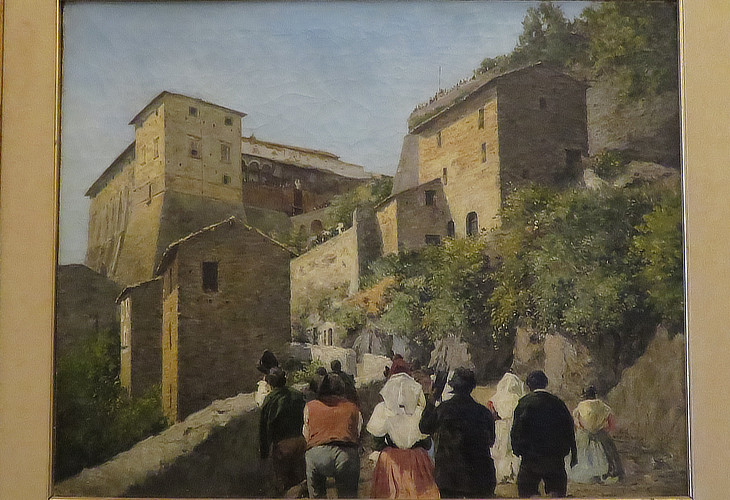
Museum inside Palazzo Colonna: Pilgrims en route to Genazzano (late XIXth century unsigned painting)
All the roads are filled with gaily dressed, orderly processions coming along towards Genazzano. (..) You heard nothing but the melancholy chanting of the processionists, who, one after another, streamed through the streets drawing on towards the church. Arrived at this goal after their long march, each seemed to forget his fatigue, and their faces beamed with fervent devotion. They fell on their knees before the church door, their hands folded on their long staves, their bundles still on their heads, singing litanies in a loud voice, and then raising the shrill cry of "Grazie, Maria!" (..) On and on the procession glided through the side aisle of the church, then in front of the altar, singing, praying, crying aloud ecstatically for pardon. That cry, "Grazie, Maria!" yelled out with frightful energy, the feverish, almost frantic, fervour with which they poured it forth, made me shudder. Gregorovius
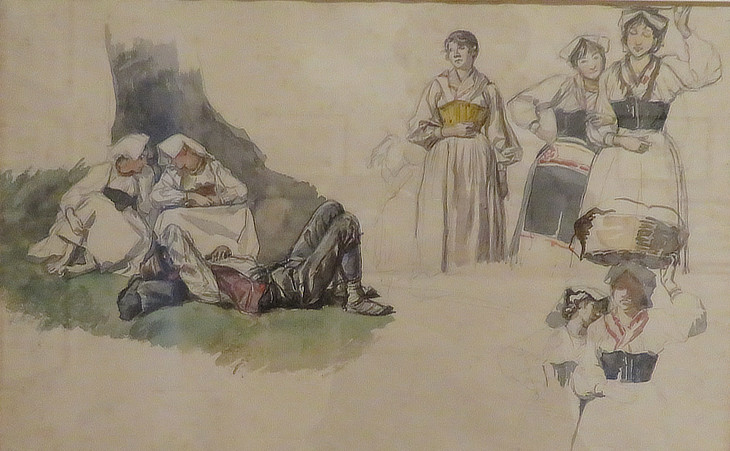
Museum inside Palazzo Colonna: Sketches of villagers by Scipione Vannutelli, a painter born at Genazzano
The town could not house all the pilgrims. As the night deepened the poor people, used to hardships, lay down on the rough pavement of the streets in crowds. They gathered round the wells and in the squares, for country people care little about losing a night's rest when travelling. (..) When they reached the last point, on their homeward way, from which Genazzano was visible, they all knelt down, their hands folded round their pilgrim-staves, and said a parting prayer. This scene beneath the free heavens seemed to me the most beautiful of all. I liked to see the women's figures as each one knelt down with such a graceful gesture, her eyes fixed on the shrine from which she was now taking her leave comforted. Gregorovius
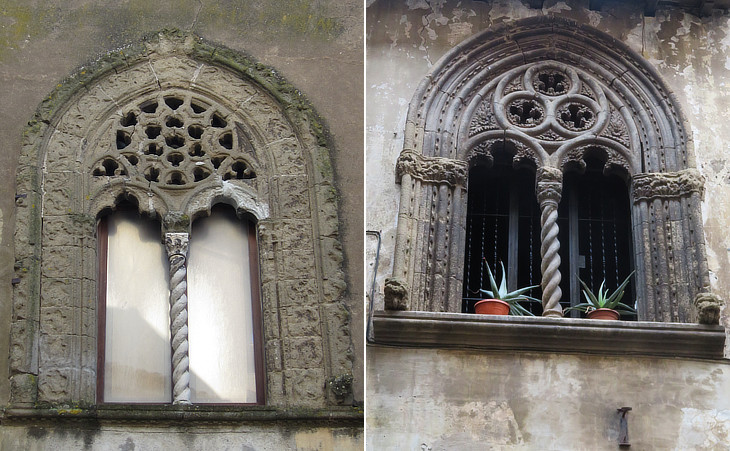
Gothic windows: (left) Casa Apolloni; (right) opposite Casa Apolloni
Miserable streets lead to the Piazza Imperiale, the principal square. The houses are sufficiently uninviting, but an occasional semi-circular Gothic window, like some withered efflorescence surviving from the Middle Ages, charms us by its Moresque rosettes. Gregorovius
Genazzano retains several elaborate Gothic windows which are deemed to have been built in the XIVth century; although similar windows can be seen in other towns near
Rome (e.g. at Tarquinia), only Genazzano has such a large number of them.
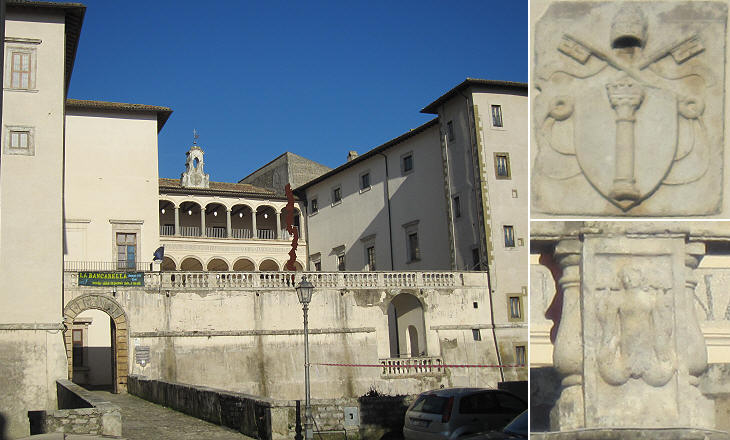
(left) Palazzo Colonna; (right-above) coat of arms of Pope Martin V; (right-below) a two-tailed mermaid, one of the heraldic symbols of the Colonna
In the beginning of the eleventh century a fortress is first mentioned in a deed, as existing at Genazzano; and this castle belonged to a Colonna of Palestrina. It gave a title and a residence to one branch of that great family. The only Pope who came of that great race is said to have been born here. This was Pope Martin V - Oddone Colonna, elected at Constance in the year 1417, with whom the Avignon schism in the Church came to an end. That great man, at all events, belonged to the Genazzano branch of the Colonna family. He delighted in the solitude of his ancestral home. He loved the place; he built churches there, and, apparently, enlarged the palace which his nephews afterwards embellished, and constructed the aqueduct. Gregorovius
The family palace was built at the beginning of the XVth century by the Pope; it was enlarged towards the end of that
century and it was partially redesigned in the early XVIIth century; on that occasion the balustrade was decorated with the Colonna
heraldic symbols.
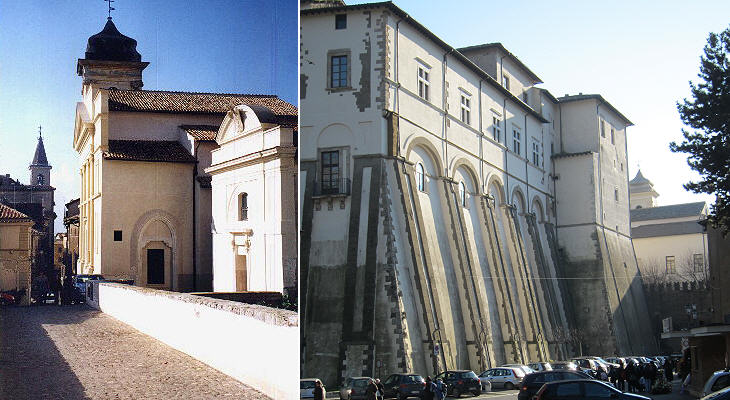
(left) S. Nicola; (right) older part of Palazzo Colonna
The medieval church of S. Nicola which stands along the main street was shortened in 1616 to facilitate the access to the palace;
the fašade was redesigned in the XIXth century.
While the side of the palace towards the town was given a gentle appearance,
the back shows the defensive purpose of the building which is usually referred to as Castello Colonna.
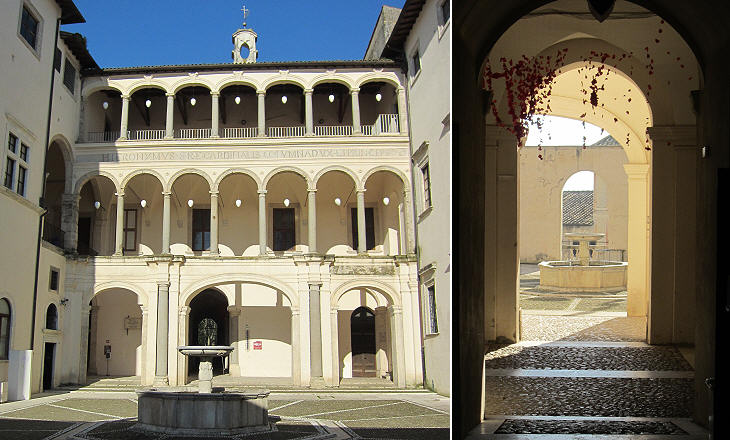
(left) Courtyard of Palazzo Colonna with inscription celebrating Cardinal Girolamo Colonna also as "dux et princeps";
(right) passage from the rear part of the building to the courtyard
At the farther end of the town is prince Colonna's palace, a large Gothic structure with battlements and a ditch. There are many noble rooms, and in an open lodge are fresco paintings of the principal estates of the family in the kingdom of Naples: from this portico is seen Capranica, a place belonging to the Prince of Palestrina as part of the Sciarra estate; it is situated on the summit of a high hill. (..) There is much of baronial magnificence in this palace, though not equal to that of Palestrina: in the court is a commodious theatre; indeed most of the noblemen's castles, in this part of Italy, had some hall set apart for dramatic representations, and the Colonnas, in particular, seem to have been great protectors of this species of entertainment. Knight
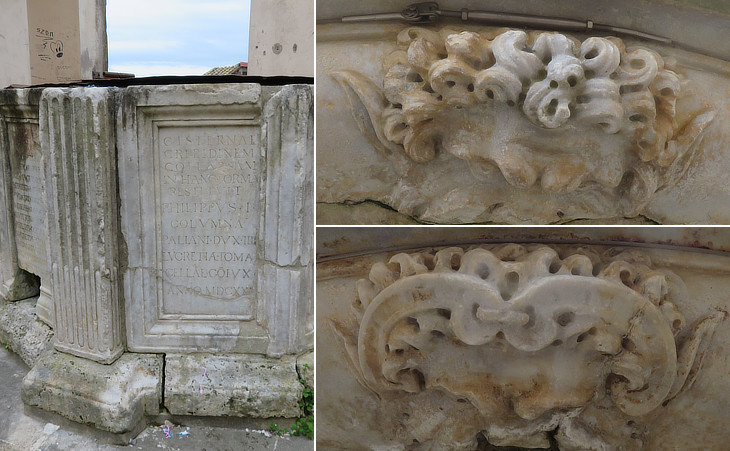
Palazzo Colonna: (left) inscription on a well which was rebuilt by Filippo I Colonna Duke of Paliano and his wife Lucrezia Tomacelli in 1621; (right) masks of satyrs which decorate the spouts of the fountain
Girolamo Colonna, son of Filippo I and Lucrezia Tomacelli was appointed cardinal in 1627 at the age of 23; in 1641 at the death of his elder brother Federico he took responsibility for managing the family fiefdoms; in 1630 the Colonna had sold Palestrina to the Barberini and Cardinal Girolamo decided to improve the palace of Genazzano; the courtyard was redesigned by Antonio del Grande with the addition of a second loggia; he was the family architect and he is best known for having designed the great gallery inside Palazzo Colonna in Rome; he also built the Colonna palace of Paliano.
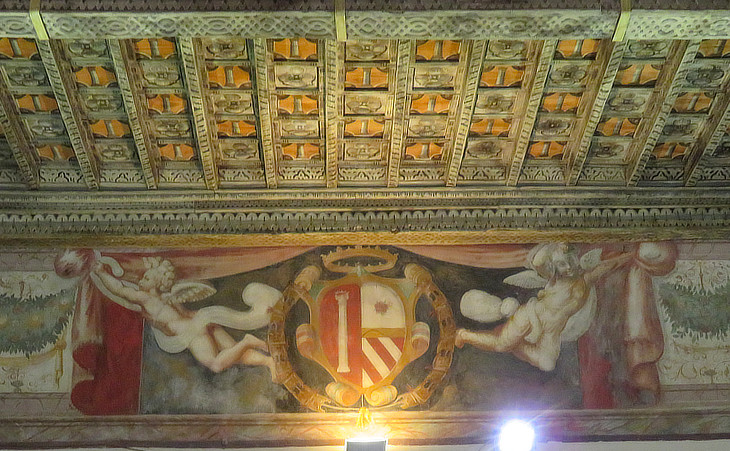
Palazzo Colonna: hall with a fresco and a ceiling with coats of arms and heraldic symbols (column and rose) of Marcantonio II Colonna and his wife Felice Orsini
In the fourteenth century, when the Popes were in exile in Avignon, they strove with the powerful Orsini for the suzerainty of the city of Rome. The Orsini became henceforth their sworn enemies, and the zealous adherents of the Papacy. (..) Marcantonio may justly be called the last great Colonna. He was buried at Pagliano in the year 1584. After his death the times were changed, the barons ceased to wage war against the Popes, but their estates were diminished by sales, to which they were driven by debts. The glory gained at Lepanto was costly. I was told by Dom Vicenzo that Marcantonio contributed a million out of the family property towards that war, and that the House of Colonna has never recovered from the expense it incurred by that expedition. Gregorovius
The marriage occurred in 1552, the groom was seventeen and the bride twelve. The Orsini and the Colonna decided it was time to make an alliance to face the growing power of the Popes. In 1577 Marcantonio was appointed Viceroy of Sicily and Felice followed him. A monumental gate of Palermo is named after her.
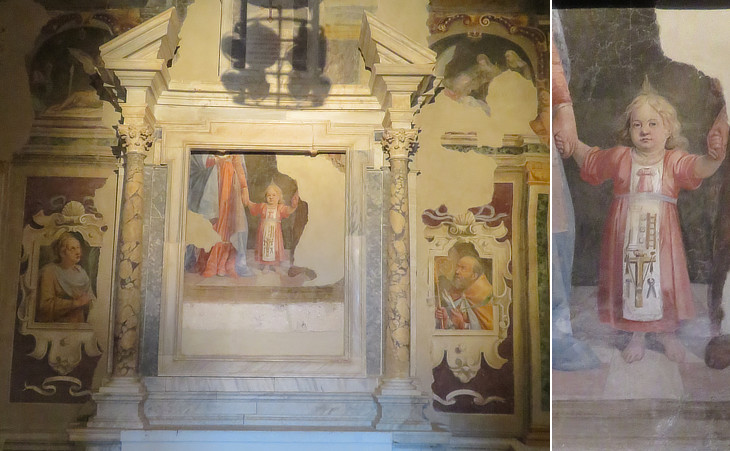
Palazzo Colonna - Cappella del Principe; it was painted in 1616 by Marzio Ganassini for Filippo I Colonnna: (left) wall of the altar; (right) detail showing the instruments of the Passion on the cloth of Jesus
In the apartments are seen many portraits of Colonnas. Knight
In his palmy days, some Colonna has had all the towns possessed by his family depicted on the walls of one of the loggias here. The frescoes have vanished, as have the rights and titles this rich family once enjoyed from all these towns. Through these lofty, empty halls creeps an aged, superannuated physician with a silvery beard, the only dweller in them now. He looks like an old world magician or sorcerer. Gregorovius
The Colonna eventually moved the portraits of their ancestors to their Roman palace.
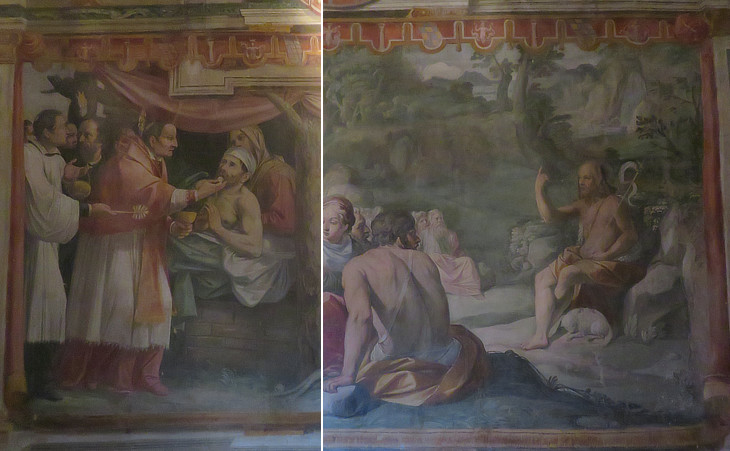
Palazzo Colonna - Cappella del Principe: (left) Cardinal Carlo Borromeo anointing the sick during the 1576 pestilence of Milan; (right) St. John the Baptist
Cardinal Borromeo's sister Anna married Fabrizio Colonna, son of Marcantonio II in 1577. The Cardinal was canonized in 1610. The frescoes by Ganassini have the appearance of tapestries and they call to mind those by Cavalier d'Arpino, the leading painter of the early XVIIth century (see his frescoes at Palazzo dei Conservatori).
In 1943 the palace was occupied by the Germans who installed some bakeries to supply bread to their troops who were fighting at Cassino and this led to its bombing which caused extensive damage to the upper floor and the loggia. Only a small chapel was spared and here and there some fragments of frescoes and ceilings. The palace was abandoned for a long period until in 1979 it was bought by the City of Genazzano.
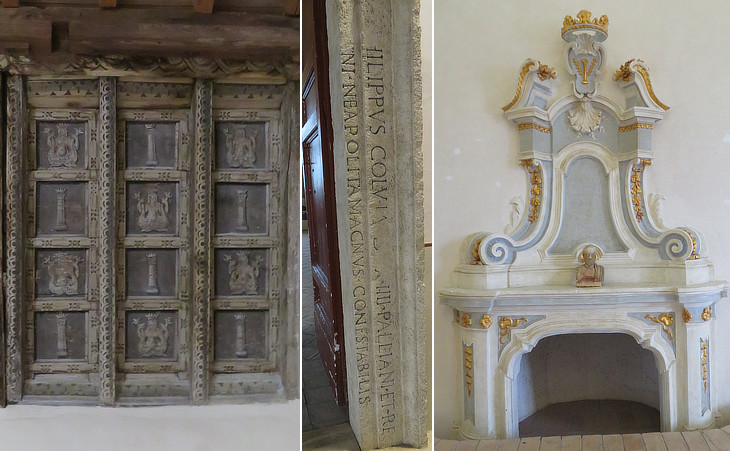
Palazzo Colonna: (left) ceiling with the Colonna heraldic symbols; (centre) inscription making reference to Filippo I as the Great Constable of the Kingdom of Naples (see a large inscription with a similar title at Palazzo Borromeo Colonna in Rome); (right) an XVIIIth century mantelpiece
Today the palace houses Museo Atelier Castello Colonna which includes a modern painting gallery and other sections covering traditional activities (e.g. the local Infiorata). You may wish to see the frescoed ceilings of two baronial palaces in towns near Genazzano: Palazzo Rospigliosi Colonna at Zagarolo (late XVIth century) and Palazzo Doria Pamphilj at Valmontone (mid-XVIIth century).

(left) Modern bridge linking Palazzo Colonna to a garden on a bastion behind the palace; (right) ruins of the aqueduct which supplied the palace
When about to take up one's residence in so remote a spot, the first desideratum, after making one's domestic arrangements, is how to find space for pleasant locomotion, good air, and green shade in which to read and reflect. The little town does not lend itself well to walking exercise, being too steep and too limited in space, with no green shady spot to sit in; but all round it are spread vineyards and chestnut groves, where one can indulge in the delights of solitude.
There is, too, a level footway, though to reach it the Colonna palace must be traversed. Behind this palace is a bridge spanning a ravine, which rests on stone arches, not unworthy of the Romans themselves. An aqueduct, now in ruins, had been constructed by the Colonna family, to convey water to their palace, and its crumbling arches look wonderfully picturesque amongst the green trees of what was once a park, but is now no less neglected than the aqueduct. Beside it runs a path which leads on to the deserted convent of San Pio.
I recall with delight that day when, on my voyage of discovery, I first explored that path through the vineyards to its terminus. Gregorovius
Bridges linked Palazzo Colonna in Rome to the gardens the family possessed on the Quirinale hill;
similarly their palace in Genazzano was linked by a bridge to a garden designed in a former defensive bastion.
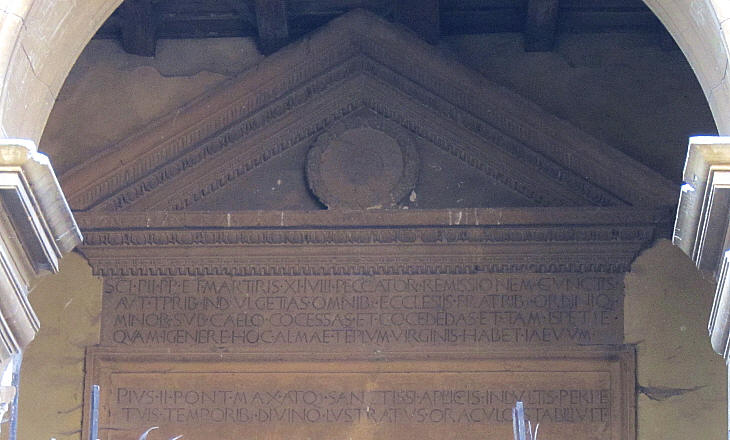
S. Pio: inscription granting indulgence which was dictated by Pope Pius II
It is easy to imagine with what excitement the country folk look forward to the harvest of the Indian corn. At the end of July the ear has been formed, and then the rain is needed. None has fallen now, but a glowing hot atmosphere pervades the fields. Every one was anxious, so they decided to pray to heaven for rain. (..) I visited the maize fields every day, and, indeed, they were very nearly ruined. At length they carried St. Anthony of Padua around in procession, and when they had taken him up to the convent of San Pio, an Augustinian monk preached, by torchlight, from the steps of the church there, the townsfolk all crowding round; some had even climbed up into the trees to hear him. A strange scene! the gesticulating monk, the image of the saint, the black cross, the white surplices of the choir-boys, the women in their red veils, the glaring light of thing torches, the dark trees, and the splendid deep blue of the vast landscape, and all this, to draw down rain from the heavens! At last the sky clouded over, the third day after this it thundered, and tropical rain rushed down in torrents, with tremendous force. Gregorovius
S. Pio was a church and convent founded in 1461 by
Pope Pius II and dedicated to Pope St. Pius I (IInd century AD).
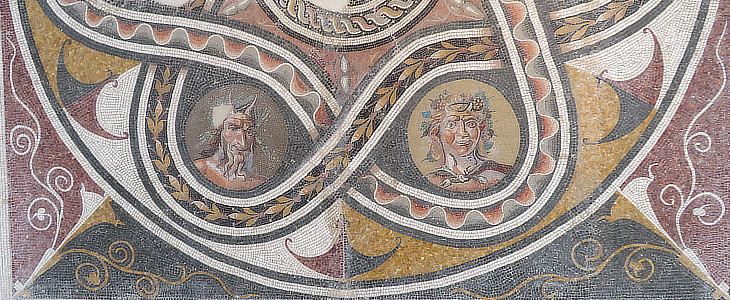
Museo Nazionale Romano: IInd century AD floor mosaic from a Roman villa near Genazzano depicting heads of a young satyr and Pan in a complex geometric frame
Introductory page on Ferdinand Gregorovius
Previous pages in this walk: Colonna and Zagarolo, Palestrina and Cave
Next pages in this walk: Olevano, Paliano and Anagni
Other walks:
The Ernici Mountains: Ferentino, Frosinone and Alatri; Fiuggi (Anticoli di Campagna); Piglio and Acuto
The Volsci Mountains: Valmontone, Segni, Norma and Cori
On the Latin shores: Anzio and Nettuno and Torre Astura plus An Excursion to Ardea and An Excursion to Lavinium (Pratica di Mare)
Circe's Cape: Terracina and San Felice
The Orsini Castle in Bracciano
Subiaco, the oldest Benedictine monastery
Small towns near Subiaco: Cervara, Rocca Canterano, Trevi and Filettino.

